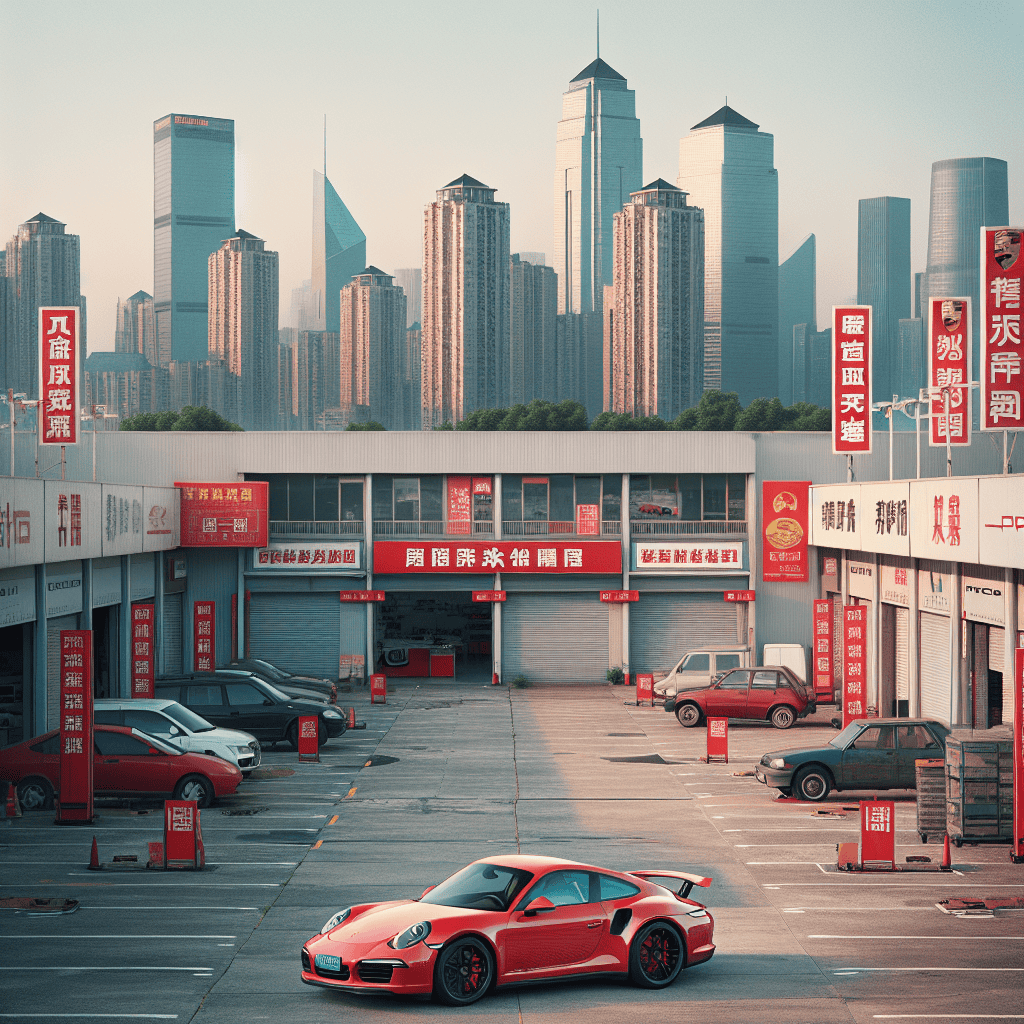“Streamlining for Success: Porsche Navigates Challenges with Strategic Dealership Reductions in China.”
Introduction
Porsche, the renowned German luxury automobile manufacturer, is strategically reducing its dealership footprint in China, a move reflecting the growing challenges in one of its most crucial markets. This decision comes amid a complex landscape characterized by shifting consumer preferences, intensifying competition, and economic uncertainties. As China remains a pivotal market for luxury carmakers, Porsche’s recalibration of its dealership network underscores the need to adapt to evolving market dynamics and maintain its competitive edge. The reduction in dealerships is part of a broader strategy to enhance operational efficiency, focus on digital sales channels, and better align with the changing demands of Chinese consumers. This development highlights the intricate balance global automakers must strike to sustain growth and profitability in an increasingly challenging environment.
Impact Of Porsche’s Decision To Reduce Dealerships In China
Porsche’s recent decision to reduce its number of dealerships in China marks a significant shift in the luxury automaker’s strategy within one of its most crucial markets. This move comes amid a confluence of challenges that have prompted the company to reassess its presence in the world’s largest automotive market. As Porsche navigates these complexities, the impact of this decision is multifaceted, affecting not only the brand’s market dynamics but also the broader automotive landscape in China.
To begin with, the reduction in dealerships is a response to the evolving consumer behavior in China. The rise of digital platforms and e-commerce has transformed how consumers engage with brands, including luxury automakers like Porsche. Increasingly, Chinese consumers are turning to online channels for research and purchasing decisions, diminishing the traditional role of physical dealerships. By scaling back its dealership network, Porsche aims to realign its resources and focus on enhancing its digital presence, thereby catering to the changing preferences of its customer base.
Moreover, the decision is influenced by the economic headwinds facing the Chinese market. Slowing economic growth and geopolitical tensions have created an environment of uncertainty, impacting consumer confidence and spending. In such a climate, maintaining an extensive network of dealerships may not be financially viable. By consolidating its physical presence, Porsche can optimize its operations and reduce overhead costs, ensuring that it remains competitive in a challenging market.
In addition to economic factors, the automotive industry in China is undergoing a significant transformation driven by the push for sustainability and the rise of electric vehicles (EVs). The Chinese government has been aggressively promoting the adoption of EVs, offering incentives and setting ambitious targets for reducing carbon emissions. This shift presents both opportunities and challenges for traditional automakers like Porsche. While the brand has made strides in developing its electric lineup, it faces stiff competition from domestic EV manufacturers who have a strong foothold in the market. By streamlining its dealership network, Porsche can allocate more resources towards innovation and the development of its electric vehicle offerings, positioning itself to better compete in this rapidly evolving sector.
Furthermore, the reduction in dealerships may have implications for Porsche’s brand perception in China. Dealerships have traditionally played a crucial role in establishing and maintaining brand prestige, offering a tangible touchpoint for consumers to experience the luxury and performance that Porsche is renowned for. However, as the brand shifts towards a more digital-centric approach, it must ensure that it continues to deliver an exceptional customer experience that aligns with its brand values. This involves leveraging technology to create immersive and personalized interactions that resonate with Chinese consumers.
In conclusion, Porsche’s decision to reduce its dealerships in China is a strategic response to a complex set of challenges and opportunities. By adapting to changing consumer behaviors, addressing economic uncertainties, and embracing the shift towards electric vehicles, Porsche aims to strengthen its position in the Chinese market. While this move may alter the traditional dealership model, it underscores the brand’s commitment to innovation and its ability to navigate the evolving automotive landscape. As Porsche continues to refine its strategy, the impact of this decision will be closely watched by industry observers and competitors alike, offering valuable insights into the future of luxury automotive brands in China.
Challenges Facing Porsche In The Chinese Automotive Market
Porsche, the renowned German luxury automobile manufacturer, is facing a series of challenges in the Chinese automotive market, prompting a strategic reduction in its dealership network across the country. This decision comes amid a complex landscape of economic, regulatory, and competitive pressures that are reshaping the dynamics of the automotive industry in China. As the world’s largest automotive market, China presents both immense opportunities and significant hurdles for global carmakers like Porsche.
One of the primary challenges confronting Porsche in China is the slowing economic growth, which has led to a more cautious consumer spending environment. The Chinese economy, once characterized by rapid expansion, is now experiencing a deceleration that has affected various sectors, including the automotive industry. This economic slowdown has resulted in a more competitive market, where luxury car brands must vie for the attention of increasingly discerning consumers. Consequently, Porsche has had to reassess its market strategy to maintain its competitive edge.
In addition to economic factors, regulatory changes in China have also posed challenges for Porsche. The Chinese government has been implementing stricter emissions standards and promoting the adoption of electric vehicles (EVs) as part of its broader environmental goals. These regulatory shifts have compelled traditional automakers to accelerate their transition towards electrification. For Porsche, which has built its reputation on high-performance internal combustion engines, this transition requires significant investment in research and development to produce electric models that meet both regulatory requirements and consumer expectations.
Moreover, the competitive landscape in China is becoming increasingly crowded, with both domestic and international players vying for market share. Chinese automakers have made substantial advancements in technology and design, offering vehicles that appeal to local tastes and preferences. This has intensified competition in the luxury segment, where Porsche operates. To navigate this environment, Porsche must differentiate itself through innovation, brand strength, and customer experience, while also adapting to local market conditions.
In response to these challenges, Porsche has decided to streamline its dealership network in China. By reducing the number of dealerships, Porsche aims to optimize its operations and focus on enhancing the quality of its customer service. This strategic move is intended to create a more efficient and effective distribution model that aligns with the evolving market dynamics. By concentrating resources on fewer, but more strategically located dealerships, Porsche seeks to strengthen its brand presence and improve customer engagement.
Furthermore, Porsche is investing in digitalization and online sales platforms to complement its physical dealership network. This approach reflects a broader industry trend towards digital transformation, driven by changing consumer behaviors and the increasing importance of online channels. By leveraging digital tools, Porsche can offer a seamless and personalized customer experience, which is crucial in maintaining its competitive position in the luxury automotive market.
In conclusion, Porsche’s decision to reduce its dealership network in China is a strategic response to the multifaceted challenges it faces in the market. Economic uncertainties, regulatory pressures, and heightened competition necessitate a reevaluation of traditional business models. By focusing on operational efficiency, digital innovation, and customer-centric strategies, Porsche aims to navigate these challenges and sustain its growth in the Chinese automotive market. As the industry continues to evolve, Porsche’s ability to adapt and innovate will be key to its success in this critical market.
Strategic Implications Of Porsche’s Dealership Reduction In China
Porsche’s recent decision to reduce its number of dealerships in China marks a significant strategic shift for the luxury automaker, reflecting broader challenges and opportunities within the Chinese market. This move comes at a time when the automotive industry is undergoing rapid transformation, driven by technological advancements, changing consumer preferences, and evolving regulatory landscapes. As Porsche navigates these complexities, the reduction in dealerships is not merely a response to immediate market conditions but a calculated step in aligning its long-term strategy with the dynamic environment of the Chinese automotive sector.
China, being the world’s largest automotive market, has long been a focal point for global car manufacturers, including Porsche. The country’s burgeoning middle class and increasing appetite for luxury goods have historically driven robust sales growth for high-end brands. However, recent economic headwinds, coupled with a shift towards electric vehicles (EVs), have introduced new challenges. The Chinese government’s push for electrification, aimed at reducing pollution and fostering sustainable development, has prompted automakers to rethink their strategies. Consequently, Porsche’s dealership reduction can be seen as part of a broader effort to recalibrate its operations in response to these evolving market dynamics.
Moreover, the rise of digitalization and e-commerce has transformed the way consumers interact with brands, including in the automotive sector. Traditional dealership models are increasingly being supplemented, and in some cases replaced, by online platforms that offer greater convenience and a more personalized customer experience. Porsche’s strategic reduction in physical dealerships may thus reflect a shift towards enhancing its digital presence, allowing the company to engage with tech-savvy Chinese consumers more effectively. By investing in digital channels, Porsche can streamline its operations, reduce overhead costs, and offer a seamless purchasing experience that aligns with contemporary consumer expectations.
In addition to these market-driven factors, Porsche’s decision is likely influenced by the competitive landscape in China. The entry of new players, particularly domestic EV manufacturers, has intensified competition, compelling established brands to differentiate themselves more clearly. By focusing on fewer, strategically located dealerships, Porsche can concentrate its resources on delivering exceptional customer service and brand experiences that reinforce its position as a premium automaker. This approach not only enhances brand loyalty but also allows Porsche to maintain its exclusivity in a crowded market.
Furthermore, the dealership reduction aligns with Porsche’s broader global strategy of sustainability and innovation. As the company accelerates its transition towards electric mobility, it is imperative to optimize its distribution network to support the rollout of new EV models. Streamlining dealership operations in China enables Porsche to allocate resources more efficiently, ensuring that its infrastructure is equipped to meet the demands of an electrified future. This strategic alignment underscores Porsche’s commitment to sustainability while reinforcing its reputation as a leader in automotive innovation.
In conclusion, Porsche’s reduction of dealerships in China is a multifaceted strategic decision that addresses both immediate market challenges and long-term objectives. By adapting to the changing landscape, embracing digitalization, and focusing on sustainability, Porsche is positioning itself to thrive in an increasingly competitive and environmentally conscious market. As the automotive industry continues to evolve, Porsche’s strategic recalibration in China serves as a testament to its agility and foresight in navigating the complexities of the global automotive landscape.
How Porsche’s China Strategy Reflects Global Automotive Trends

Porsche’s recent decision to reduce its number of dealerships in China marks a significant shift in its strategy within one of the world’s largest automotive markets. This move is not merely a response to immediate challenges but also reflects broader global trends in the automotive industry. As the landscape of car manufacturing and sales evolves, Porsche’s actions in China offer a microcosm of the strategies being adopted by luxury car manufacturers worldwide.
The decision to scale back on physical dealerships in China comes amid a confluence of factors that are reshaping the automotive market. One of the primary drivers is the rapid digitalization of car sales. With the rise of e-commerce and digital platforms, consumers are increasingly comfortable making significant purchases online, including luxury vehicles. This shift reduces the necessity for a large number of physical showrooms, allowing companies like Porsche to streamline operations and focus on enhancing their digital presence. By investing in online sales channels, Porsche can reach a broader audience while reducing overhead costs associated with maintaining numerous brick-and-mortar locations.
Moreover, the Chinese automotive market is experiencing a shift in consumer preferences, with a growing emphasis on electric vehicles (EVs). As environmental concerns and government regulations push for a reduction in carbon emissions, the demand for EVs is surging. Porsche, known for its high-performance sports cars, is adapting to this trend by expanding its electric vehicle lineup. The Taycan, Porsche’s flagship electric model, has been well-received in China, indicating a successful pivot towards sustainable mobility. By focusing on EVs, Porsche aligns itself with global efforts to combat climate change while catering to the evolving tastes of Chinese consumers.
In addition to these market dynamics, economic factors also play a crucial role in Porsche’s strategic adjustments. The Chinese economy has been experiencing fluctuations, with growth rates slowing down compared to previous years. This economic uncertainty affects consumer spending patterns, particularly in the luxury segment. By optimizing its dealership network, Porsche can better manage its resources and maintain profitability in a challenging economic environment. This approach mirrors strategies employed by other luxury brands worldwide, which are increasingly prioritizing efficiency and adaptability in response to economic volatility.
Furthermore, Porsche’s strategy in China is indicative of a broader trend towards brand experience and customer engagement. As competition intensifies, luxury car manufacturers are focusing on creating unique and personalized experiences for their customers. By reducing the number of dealerships, Porsche can concentrate on enhancing the quality of its existing locations, transforming them into experiential centers where customers can immerse themselves in the brand’s heritage and innovation. This shift from quantity to quality is a hallmark of modern luxury retail, where the emphasis is on building lasting relationships with customers rather than merely facilitating transactions.
In conclusion, Porsche’s decision to reduce its dealership footprint in China is a strategic response to a rapidly changing automotive landscape. By embracing digitalization, focusing on electric vehicles, and enhancing customer experiences, Porsche is not only addressing immediate challenges but also positioning itself for long-term success. This approach reflects broader global trends in the automotive industry, where adaptability and innovation are key to navigating an increasingly complex market. As Porsche continues to refine its strategy, its actions in China will likely serve as a blueprint for other luxury car manufacturers seeking to thrive in a dynamic global environment.
The Future Of Luxury Car Brands In China’s Evolving Market
In recent years, the landscape of the luxury car market in China has undergone significant transformations, prompting major brands to reassess their strategies. Among these brands, Porsche has made headlines by announcing a reduction in its dealership network across China. This decision comes amid a confluence of challenges that luxury car manufacturers face in the world’s largest automotive market. As the Chinese economy experiences fluctuations and consumer preferences evolve, luxury car brands are compelled to adapt to maintain their foothold.
Porsche’s decision to scale back its dealership presence in China is indicative of broader trends affecting the luxury automotive sector. The Chinese market, once characterized by rapid growth and insatiable demand for luxury vehicles, is now experiencing a period of maturation. Economic uncertainties, including trade tensions and a slowing GDP growth rate, have contributed to a more cautious consumer base. Consequently, luxury car brands are witnessing a shift in consumer behavior, with potential buyers becoming more discerning and value-conscious.
Moreover, the rise of electric vehicles (EVs) and the Chinese government’s push for sustainable transportation have added another layer of complexity to the market dynamics. As environmental concerns take center stage, consumers are increasingly gravitating towards EVs, which offer both luxury and sustainability. This shift has prompted traditional luxury car manufacturers, including Porsche, to invest heavily in electric technology to remain competitive. However, the transition to electric mobility is not without its challenges, as it requires substantial investment in research and development, as well as the establishment of new supply chains.
In addition to these economic and technological factors, cultural shifts are also influencing the luxury car market in China. The younger generation of Chinese consumers, who are more digitally savvy and globally connected, prioritize experiences over material possessions. This change in mindset has led to a growing interest in car-sharing services and other mobility solutions that offer flexibility and convenience. As a result, luxury car brands are exploring new business models that cater to these evolving preferences, such as subscription services and experiential marketing initiatives.
Despite these challenges, the Chinese market remains a critical component of Porsche’s global strategy. The brand’s decision to reduce its dealership network does not signify a retreat but rather a strategic realignment to optimize its operations. By focusing on key urban centers and enhancing digital sales channels, Porsche aims to streamline its distribution model and improve customer engagement. This approach allows the brand to maintain its exclusivity while adapting to the changing market environment.
Furthermore, Porsche’s commitment to innovation and sustainability positions it well to navigate the evolving landscape. The brand’s investment in electric vehicles, exemplified by models like the Taycan, underscores its dedication to meeting the demands of environmentally conscious consumers. By aligning its product offerings with the growing emphasis on sustainability, Porsche is poised to capture a significant share of the burgeoning EV market in China.
In conclusion, the reduction of Porsche’s dealership network in China reflects the broader challenges and opportunities facing luxury car brands in an evolving market. As economic, technological, and cultural shifts reshape consumer behavior, brands must adapt their strategies to remain relevant. By embracing innovation and sustainability, while optimizing their distribution models, luxury car manufacturers like Porsche can continue to thrive in China’s dynamic automotive landscape.
Analyzing Porsche’s Response To Economic Shifts In China
Porsche’s recent decision to reduce its dealership presence in China marks a significant shift in its strategy within one of the world’s most lucrative automotive markets. This move comes amid a confluence of economic challenges and evolving consumer preferences that are reshaping the landscape for luxury car manufacturers. As China grapples with a slowing economy and changing regulatory environment, Porsche’s response highlights the complexities of navigating these shifts while maintaining its brand prestige and market share.
The Chinese market has long been a cornerstone of Porsche’s global strategy, contributing significantly to its sales and revenue. However, recent economic indicators suggest a deceleration in growth, prompting luxury brands to reassess their positions. The Chinese government’s focus on economic restructuring, coupled with trade tensions and a more cautious consumer base, has created an environment where traditional business models are being tested. In this context, Porsche’s decision to streamline its dealership network can be seen as a proactive measure to align with the new economic realities.
Moreover, the rise of digitalization and e-commerce in China has transformed consumer behavior, with more buyers opting for online platforms to research and purchase vehicles. This shift necessitates a reevaluation of the traditional dealership model, which has been a staple of luxury car sales. By reducing its physical footprint, Porsche is likely aiming to invest more in digital channels, enhancing its online presence to cater to tech-savvy consumers. This strategic pivot not only aligns with current trends but also positions Porsche to capitalize on future opportunities in the digital realm.
In addition to economic and technological factors, environmental considerations are increasingly influencing automotive strategies. China’s stringent emissions regulations and its push towards electric vehicles (EVs) are compelling luxury carmakers to innovate and adapt. Porsche, known for its high-performance combustion engines, is now investing heavily in electric mobility. The introduction of models like the Taycan, Porsche’s first fully electric sports car, underscores its commitment to sustainability and its intent to meet regulatory demands. By reducing dealerships, Porsche can potentially allocate more resources towards developing and marketing its EV lineup, ensuring compliance and competitiveness in a rapidly evolving market.
Furthermore, the reduction in dealerships may also reflect a strategic focus on quality over quantity. By concentrating on fewer, more strategically located outlets, Porsche can enhance the customer experience, offering personalized services that align with the expectations of luxury consumers. This approach not only reinforces brand loyalty but also differentiates Porsche in a crowded market where customer experience is paramount.
While the reduction of dealerships might seem like a retreat, it is, in fact, a recalibration of Porsche’s strategy to better align with the current and anticipated market dynamics. By embracing digital transformation, focusing on sustainability, and enhancing customer experience, Porsche is positioning itself to navigate the challenges and opportunities presented by the Chinese market. This strategic shift underscores the importance of adaptability and foresight in an industry characterized by rapid change and intense competition.
In conclusion, Porsche’s decision to reduce its dealership presence in China is a multifaceted response to the economic, technological, and environmental shifts shaping the automotive landscape. As the company continues to innovate and adapt, it remains poised to maintain its status as a leader in the luxury automotive sector, even amid the complexities of the Chinese market.
Lessons From Porsche’s Adaptation To The Chinese Market Dynamics
Porsche’s recent decision to reduce its number of dealerships in China marks a significant shift in its strategy within one of the world’s most lucrative automotive markets. This move, while seemingly counterintuitive given China’s vast consumer base, underscores the complex dynamics at play in the region and offers valuable lessons in adaptation and strategic foresight. As the Chinese market evolves, so too must the strategies of companies operating within it, and Porsche’s actions provide a case study in navigating these changes.
The decision to scale back on dealerships is not a reflection of diminished interest in the Chinese market but rather an adaptation to its changing landscape. Over the past decade, China has emerged as a critical market for luxury car manufacturers, driven by a burgeoning middle class and increasing demand for high-end vehicles. However, recent economic fluctuations, coupled with shifts in consumer behavior, have prompted companies like Porsche to reassess their approach. By reducing the number of physical dealerships, Porsche is responding to a growing trend among Chinese consumers who are increasingly turning to digital platforms for their purchasing decisions. This shift towards online engagement necessitates a reevaluation of traditional brick-and-mortar strategies.
Moreover, the reduction in dealerships aligns with Porsche’s broader global strategy of enhancing customer experience and brand exclusivity. By focusing on fewer, more strategically located dealerships, Porsche aims to provide a more personalized and premium service to its clientele. This approach not only reinforces the brand’s luxury image but also allows for a more efficient allocation of resources, ensuring that each dealership is equipped to deliver the high standards expected by Porsche customers. This strategic realignment highlights the importance of quality over quantity, a principle that is becoming increasingly relevant in today’s competitive market environment.
In addition to adapting to consumer preferences, Porsche’s decision is also influenced by regulatory changes and environmental considerations. China’s stringent emissions regulations and the government’s push towards electric vehicles (EVs) have compelled automakers to innovate and invest in sustainable technologies. Porsche, known for its high-performance sports cars, is no exception. The company has been actively expanding its EV lineup, with models like the Taycan gaining popularity among environmentally conscious consumers. By reducing its physical footprint, Porsche can redirect resources towards research and development in sustainable technologies, ensuring compliance with regulations while meeting the evolving demands of the market.
Furthermore, Porsche’s strategic shift serves as a reminder of the importance of agility in business operations. In a rapidly changing global landscape, the ability to pivot and adapt is crucial for long-term success. Companies must remain vigilant, continuously monitoring market trends and consumer behaviors to make informed decisions. Porsche’s proactive approach in China exemplifies this mindset, demonstrating that even established brands must be willing to evolve to maintain their competitive edge.
In conclusion, Porsche’s reduction of dealerships in China is a multifaceted strategy that reflects the complexities of the modern automotive market. By embracing digital transformation, prioritizing customer experience, and aligning with regulatory and environmental trends, Porsche is positioning itself for sustained success in a challenging environment. This case study offers valuable insights into the necessity of adaptation and strategic foresight, lessons that are applicable not only to the automotive industry but to businesses across all sectors navigating the intricacies of a dynamic global market.
Q&A
1. **Why is Porsche reducing its dealerships in China?**
Porsche is reducing its dealerships in China due to slowing economic growth, increased competition, and changing consumer preferences in the automotive market.
2. **How many dealerships is Porsche planning to close in China?**
The exact number of dealerships Porsche plans to close has not been specified, but the reduction is part of a strategic realignment to optimize its sales network.
3. **What challenges is Porsche facing in the Chinese market?**
Porsche is facing challenges such as economic slowdown, intensified competition from both local and international car manufacturers, and a shift towards electric vehicles.
4. **How is the Chinese automotive market changing?**
The Chinese automotive market is experiencing a shift towards electric vehicles, increased competition, and changing consumer preferences, impacting traditional luxury car brands.
5. **What strategies is Porsche implementing to address these challenges?**
Porsche is focusing on enhancing its digital sales channels, investing in electric vehicle technology, and optimizing its dealership network to better align with market demands.
6. **How might these dealership reductions affect Porsche’s sales in China?**
While there may be short-term impacts on sales, Porsche aims to improve long-term profitability and market presence by focusing on more strategic locations and digital sales.
7. **Is Porsche planning to increase its focus on electric vehicles in China?**
Yes, Porsche is increasing its focus on electric vehicles in China, aligning with the country’s growing demand for sustainable and environmentally friendly transportation options.
Conclusion
Porsche’s decision to reduce its dealership presence in China reflects the growing challenges in the world’s largest automotive market. This move may be attributed to several factors, including increased competition from both domestic and international brands, changing consumer preferences, and economic uncertainties. Additionally, the rise of electric vehicles and the push for sustainability may be influencing Porsche’s strategic realignment. By consolidating its dealership network, Porsche could be aiming to optimize its operations, focus on high-performing locations, and enhance customer experience. This strategic shift underscores the need for luxury automakers to adapt to evolving market dynamics and consumer demands in China.





